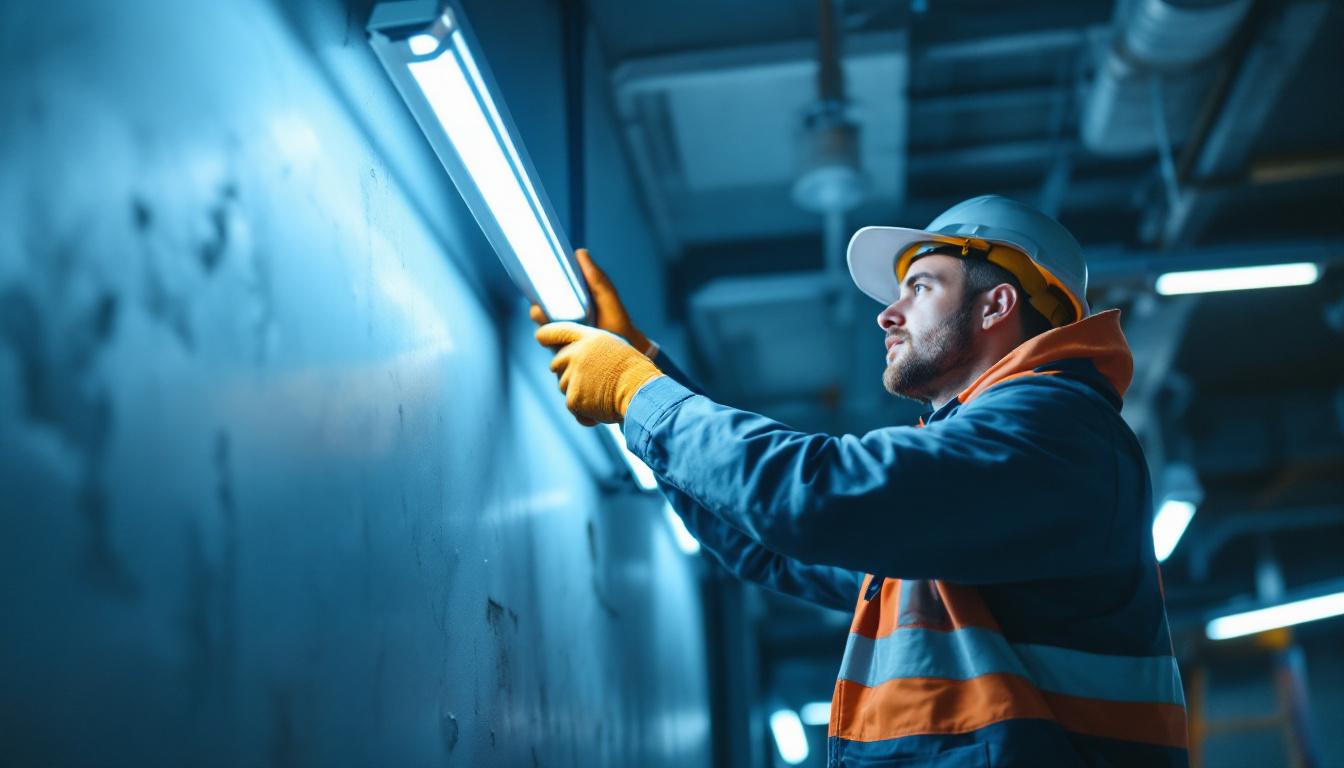
Replacing fluorescent tube lights is a task that many lighting contractors encounter frequently. While the process may seem straightforward, there are several common mistakes that can lead to inefficiencies, increased costs, and unsatisfactory results. Understanding these pitfalls can help contractors improve their practices and deliver better service to their clients.
Before diving into the common mistakes, it is essential to grasp the fundamentals of fluorescent tube lights. These lights operate by passing an electric current through a gas, which then emits ultraviolet light. This light interacts with a phosphor coating inside the tube, producing visible light. When replacing these tubes, contractors must consider not only the type of tube but also the fixture and ballast compatibility. The efficiency and lifespan of fluorescent tubes can vary significantly based on their construction and the materials used, making it vital to understand the specifications of the products being used.
Fluorescent tubes come in various sizes and color temperatures, which can affect the ambiance of a space. Selecting the right tube for a specific application is crucial, as it influences energy efficiency and overall performance. For instance, cooler color temperatures (above 5000K) are often preferred in workspaces for their stimulating effects, while warmer temperatures (below 3000K) are more suitable for residential settings to create a cozy atmosphere. A thorough understanding of these components will help contractors avoid common errors during the replacement process, ensuring that the lighting not only meets functional requirements but also enhances the aesthetic appeal of the environment.
One of the most significant mistakes contractors make is selecting the wrong replacement tubes. It is essential to match the wattage, length, and type of the existing tubes. For instance, a contractor might replace a T8 tube with a T12 tube, which can lead to compatibility issues with the existing ballast. Furthermore, the lumen output of the replacement tube should also be taken into account, as different tubes can emit varying levels of brightness. This is particularly important in commercial settings where consistent lighting is crucial for productivity and safety.
Additionally, contractors should pay attention to the color temperature of the tubes. Using tubes with a different color temperature than the original can dramatically change the lighting quality in a space, potentially leading to customer dissatisfaction. The color rendering index (CRI) is another important factor to consider; a higher CRI value indicates that colors will appear more vibrant and true to life under the light. Always check the specifications and ensure that the replacement tubes align with the client’s expectations, as this attention to detail can significantly enhance the overall satisfaction with the lighting installation.
Ballasts play a crucial role in the operation of fluorescent lights, regulating the current that flows to the tubes. A common mistake is neglecting to verify the compatibility of the new tubes with the existing ballast. Some tubes are designed to work with electronic ballasts, while others may require magnetic ballasts. Understanding the differences between these ballasts can help in selecting the right components; for example, electronic ballasts are generally more energy-efficient and can improve the performance of the fluorescent tubes.
Replacing a tube without considering ballast compatibility can lead to flickering lights, reduced efficiency, or even damage to the new tubes. It is essential to assess the ballast type before proceeding with the replacement to ensure a smooth operation. Additionally, some modern LED tubes are designed to be direct replacements for fluorescent tubes, often bypassing the ballast altogether. This can provide an opportunity for contractors to upgrade the lighting system while enhancing energy savings and reducing maintenance costs. Exploring these options can lead to more sustainable and cost-effective lighting solutions for clients, making it a worthwhile consideration during the replacement process.
Even with the right materials, improper installation can lead to subpar performance of fluorescent tube lights. Contractors must be meticulous in their approach to ensure that the new tubes function correctly and provide optimal illumination.
One of the most straightforward yet frequently overlooked mistakes is improper tube installation. Fluorescent tubes must be securely seated in their sockets to ensure a proper connection. If the tubes are not fully inserted, they may flicker or fail to light up altogether.
Additionally, contractors should ensure that the pins on the tubes are clean and free from corrosion. Dirty or corroded pins can hinder the electrical connection, leading to performance issues. Taking the time to inspect and clean the sockets can prevent these problems from arising.
Safety should always be a top priority during any lighting installation. Neglecting safety protocols can lead to accidents, injuries, or damage to the property. Contractors must ensure that the power is turned off before beginning any work and use appropriate personal protective equipment.
Furthermore, it is essential to dispose of old fluorescent tubes properly. These tubes contain hazardous materials, such as mercury, which require special handling. Failing to follow proper disposal procedures can pose environmental risks and legal liabilities.
Energy efficiency is a significant factor in modern lighting design. Many clients are looking to reduce their energy consumption and lower their utility bills. Contractors who overlook energy efficiency considerations may miss opportunities to provide added value to their clients.
One common mistake is not suggesting LED alternatives when replacing fluorescent tubes. LED technology has advanced significantly, offering longer lifespans and lower energy consumption compared to traditional fluorescent tubes. By failing to recommend LED options, contractors may limit their clients’ potential savings and environmental benefits.
Moreover, many LED tubes are designed to be direct replacements for fluorescent tubes, making the transition relatively seamless. Educating clients about the advantages of LED lighting can enhance their satisfaction and lead to more referrals for the contractor.
Before replacing fluorescent tubes, conducting an energy audit can provide valuable insights into a facility’s lighting needs. Many contractors skip this step, which can lead to inefficient replacements that do not address the client’s energy consumption goals.
An energy audit helps identify areas where lighting can be optimized, ensuring that the replacement tubes align with the overall energy strategy. This proactive approach can save clients money in the long run and position the contractor as a knowledgeable partner in energy efficiency.
Effective communication is vital in any contractor-client relationship. Misunderstandings can lead to mistakes and dissatisfaction, making it essential for contractors to engage in clear and open dialogue with their clients throughout the replacement process.
One common communication pitfall is failing to set realistic expectations regarding the replacement process. Contractors should clearly explain the timeline, potential disruptions, and any limitations associated with the new tubes. By managing expectations, contractors can foster trust and reduce the likelihood of client dissatisfaction.
Additionally, it is important to discuss the expected performance of the new tubes. Clients may have specific lighting preferences, and it is crucial to ensure that the selected tubes will meet those needs. Open communication can help align the contractor’s recommendations with the client’s vision.
After the installation is complete, many contractors neglect to follow up with their clients. This step is vital for ensuring that the new lighting meets the client’s expectations and functions as intended. A simple follow-up can help identify any issues early on and demonstrate the contractor’s commitment to customer satisfaction.
Moreover, follow-up communication can provide an opportunity to discuss any additional lighting needs or potential upgrades. This proactive approach can lead to repeat business and referrals, strengthening the contractor’s reputation in the industry.
The lighting industry is constantly evolving, with new technologies and best practices emerging regularly. Contractors who fail to stay informed about these trends may find themselves at a disadvantage, making mistakes that could have been avoided with updated knowledge.
One of the most significant mistakes is not keeping up with technological advancements in lighting. New products, such as smart lighting systems and advanced LED technologies, can provide enhanced performance and energy efficiency.
Contractors should invest time in ongoing education and training to stay informed about the latest developments in the industry. This knowledge can help them make informed recommendations to clients and avoid outdated practices that could hinder performance.
Regulatory changes can also impact lighting installations, particularly concerning energy efficiency standards. Contractors who are unaware of these changes may inadvertently violate regulations, leading to fines or project delays.
Staying informed about local, state, and federal regulations is essential for compliance and ensuring that installations meet the required standards. By keeping abreast of regulatory changes, contractors can avoid costly mistakes and maintain their credibility in the industry.
Replacing fluorescent tube lights may seem like a routine task for lighting contractors, but it is fraught with potential pitfalls. By understanding and addressing common mistakes, contractors can enhance their professionalism and deliver superior service to their clients.
From choosing the right replacement tubes to ensuring proper installation and communication, each step in the process is critical. By remaining vigilant and committed to continuous improvement, contractors can not only avoid mistakes but also position themselves as trusted experts in the lighting industry.
Ultimately, the goal is to create a positive experience for clients while delivering high-quality lighting solutions. By focusing on these common mistakes and striving for excellence, contractors can build lasting relationships with their clients and contribute to a more sustainable future in lighting.
Don’t let common mistakes compromise your lighting projects. At LumenWholesale, we provide lighting contractors with the highest quality, spec-grade lighting products at prices that can’t be beaten. Say goodbye to inflated markups and hello to a vast selection of reliable, high-performance lighting that meets the most stringent industry standards. With free shipping on bulk orders, you can stock up on premium lighting solutions without worrying about hidden fees. Elevate your lighting installations and avoid costly errors with the unbeatable value and convenience of Wholesale Lighting at the Best Value from LumenWholesale.

Discover the often-overlooked aspects of outdoor patio light fixtures that even seasoned lighting contractors miss.

Discover how home outside lights can transform your exterior spaces from ordinary to extraordinary.

Discover essential splicing LED strips tools for lighting contractors.

Discover how incorporating patio post lights into your design portfolio can elevate your lighting projects and help you secure more contracts.